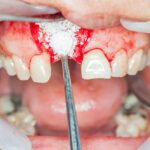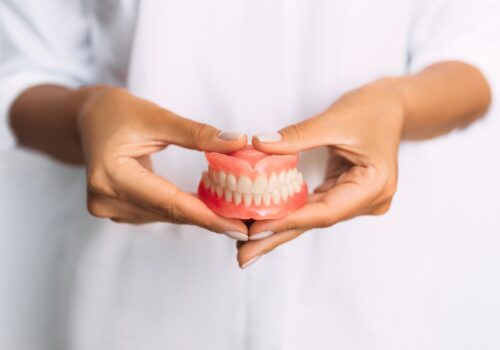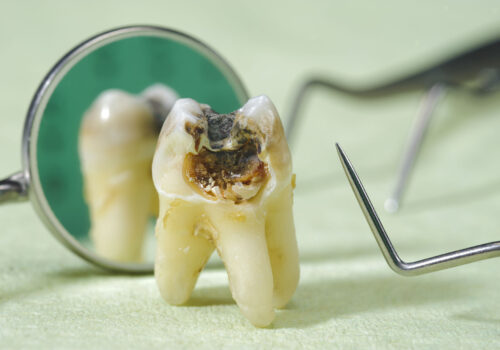
Periodontal (gum) disease is a family of bacterial diseases that infect the soft gum tissues and ligaments around the teeth. Untreated gum disease can cause damaged tissues to recede and detach from the teeth, eventually leading to tooth loss. There’s also growing evidence that the gum inflammation that arises from the disease may be linked to other inflammatory conditions like cardiovascular disease, diabetes and, for pregnant women, premature delivery of their babies.
Gum disease can be treated effectively, especially in its early stages. The treatment must be thorough and sometimes invasive. It also requires a renewed, personal commitment to daily oral hygiene to keep the disease under control and promote long-term healing in your gums.
Plaque—the Main Cause of Gum Disease (Periodontal Disease)
Bacterial plaque accumulating on teeth and gums is the main culprit behind gum disease. The primary cause for this breeding ground of bacteria is inadequate daily oral hygiene. If the bacteria in plaque remain undisturbed, they’ll continue to advance below the gum line, causing damage to the underlying gum attachment and surrounding bone around the tooth roots. This entrenchment is the main reason that 70% of people with advanced gum disease develop a chronic form that worsens with age.
The body’s immune system fights this threatening infection with an inflammatory response, a normal defense mechanism intended to isolate bacteria and rid it from the body. If the two sides in this war stalemate in their positions, the inflammation becomes chronic—and begins to harm the tissues it’s supposed to protect.
This gives rise to signs and symptoms that, if noticed early, can alert you to seek treatment: redness, swelling and bleeding of the gums, and sometimes bad breath and taste. Symptoms like loose or shifting teeth indicate that some of the gum tissues may have already begun to detach from the teeth, an advanced stage of the disease. If you see any of these signs, you should visit your dentist promptly for an accurate diagnosis and initial treatment.
What is Burning Mouth Syndrome?
Basic and Advanced Treatments for Gum / Periodontal Disease
Basic Treatment for Periodontal Disease
The basic treatment for gum disease is the thorough removal of plaque and calculus (hardened deposits of plaque) from tooth surfaces, including below the gum line around the tooth roots and bone. A dentist or hygienist performs this action manually, typically with local anesthesia or another means of alleviating pain or discomfort.
Dentists perform the removal action called scaling using special instruments called scalers or an ultrasonic device that vibrates the plaque loose. The loosened plaque is then flushed away with water. Root planing accesses the tooth roots to clean or “plane” plaque and calculus (tartar) from root surfaces. You may also undergo antibiotic therapy or use anti-bacterial mouthrinses to reduce the mouth’s bacterial levels.
Following the first cleaning session, you’ll return to the dentist a few weeks later to see how the inflamed tissues have responded to treatment. If the inflammation has subsided, more plaque and calculus deposits may become apparent and will require further scaling for removal. The more plaque and calculus removed, the more the infection and inflammation will subside and the tissues heal.
Advanced Treatment for Periodontal Disease
Advanced cases of gum disease can give rise to a number of difficult problems that require more invasive techniques.In some cases, the damaged gum tissue may lose attachment to the teeth, causing the normally small space between teeth and gums to widen. This leads to the formation of inflamed, often pus-filled periodontal “pockets” that require thorough cleaning.
While basic scaling can generally reach pockets near the surface, those situated 5 millimeters or more below the gum line may necessitate surgical access. periodontists use a procedure called flap surgery for this purpose, where they create an opening in the gum resembling the flap of a paper envelope. They clean the pocket thoroughly, and then suture the flap back into place.
Teeth with multiple roots may also cause complications. The point where the roots divide, known as a furcation, can become infected and result in significant bone loss at the furcation. Surgery may be necessary to reach it, as well as other procedures to promote bone and gum tissue re-growth, and to make the area more accessible for future cleaning and maintenance.
Other areas may require surgical repair due to extensive tissue loss and bone loss. Dentists often use bone and tissue grafting to repair and stimulate new growth in cases where normal re-growth from healing is unlikely. This results in both healthier teeth and gums and may improve the cosmetic appearance.
Controlling Gum Disease Now and in the Future

These extensive treatments are no guarantee your gum disease will not recur. It’s vital, therefore, for you to remain vigilant and cultivate a strong, daily hygiene habit, as well as stop harmful habits such as tobacco use. Daily brushing and flossing removes plaque; regular dental cleanings (at least twice a year or more) remove hard-to-reach plaque and calculus. Changing your eating habits to a more dental-friendly diet can help prevent gum disease and other dental diseases. This includes eating more fruits and vegetables while consuming less sugar and other carbohydrates that contribute to bacterial damage.
Proactive treatment, good hygiene habits and vigilant monitoring will keep gum disease under control, and help ensure you a lifetime of healthy teeth and gums.







Pingback: Tooth Extraction: Causes and Treatment Options - UDENZ - MENA DENTAL PLATFORM